Your basket is currently empty!
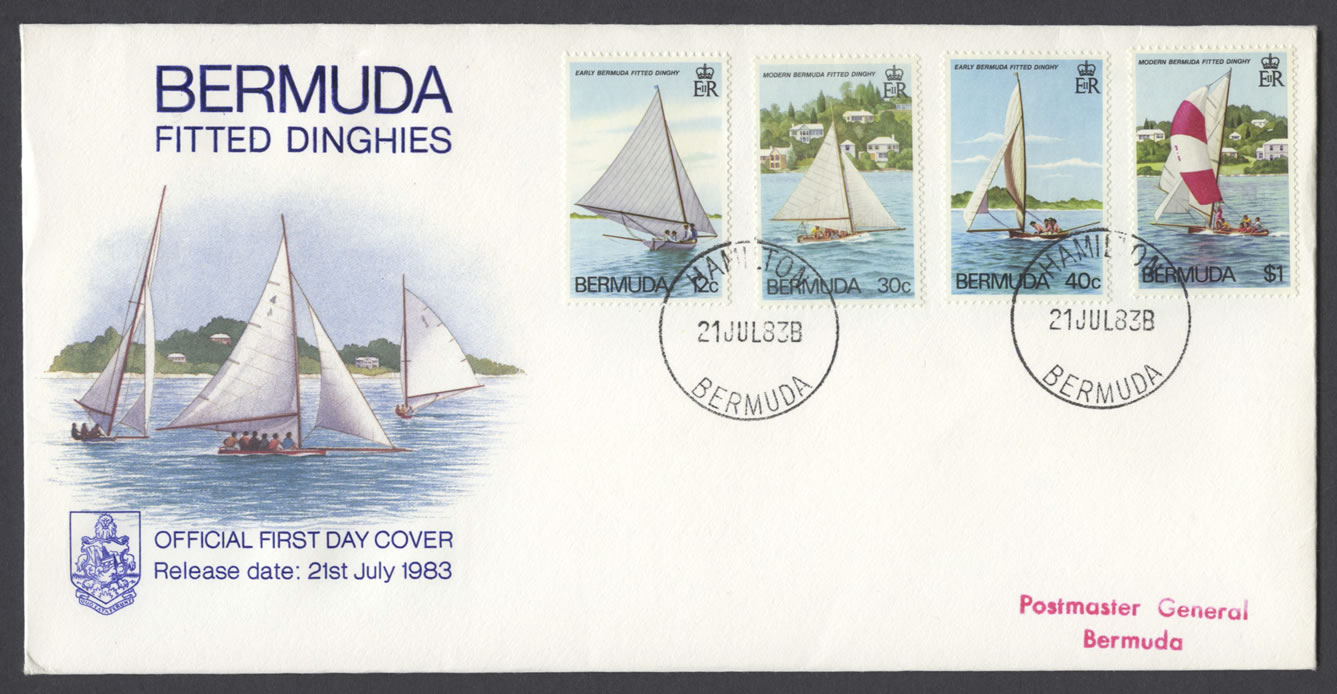
1983 Bermuda Fitted Dinghies
Bermuda Racing Dinghies
Date: 21st July 1983
Stamps: BERMUDA 12c EARLY BERMUDA FITTED DINGHY; 30c MODERN BERMUDA FITTED DINGHY; 40c EARLY BERMUDA FITTED DINGHY and $1 MODERN BERMUDA FITTED DINGHY
Official First Day Cover
Cachet: BERMUDA FITTED DINGHIES OFFICIAL FIRST DAY COVER Release date: 21st July 1983
CDS: 21JUL83B HAMILTON BERMUDA
Address: Postmaster General Bermuda
BERMUDA RACING DINGHIES
by Dr J C Arnell
When competitive racing with “one masted open boats 12 feet keel and under” began in the 1850s, the craft were small family boats, which were normally used to travel between the islands or along the shore of the main island in the absence of adequate land transport.
These boats could be rowed or sailed, depending on weather conditions. The sail was lashed to the mast and rolled around it when not in use. The hulls were usually built of Bermuda cedar and had a 3-4 inch cedar keel along the length of the bottom. Usually a family could be distributed in a boat in such a way as to act as ballast when sailing; alternatively, when being sailed with only one or two persons aboard, sandbags or pieces of lead with rope through them would be carried for use as “shifting ballast”, to be moved from side to side on successive tacks into the wind.
When racing, these boats would be specially “fitted”, and this fitting became more elaborate as dinghy racing developed and spread to all parts of the islands. From the start, it is certain that the regular competitors would have had a set of larger sails and possibly a longer mast to carry them for race days. This extra canvas would be counterbalanced by a crew of four or six, and additional shifting ballast.
The next addition to the fitting process was the temporary use of an iron fin or keel. As this would have interfered with the normal use of the boats, preventing them from being beached on the shore, the fin was bolted through the cedar keel, so that it was held against one side of it. Just when this was first done is not known, but the practice was established before 1870. It is probable that boats built purely for racing were the first to have iron keels mounted permanently on the hulls. This would have allowed for some streamlining and so give better performance. If so, it is likely that an 1878 dinghy was the first.
The next stage in the development of “fitted dinghies” was the introduction of temporary decking to reduce the amount of water shipped when racing. As long as the dinghies were still primarily for family purposes, they were most useful as open boats. Here again the start of this practice is obscure. There is an early reference to small decked boats in 1844, but no detail is given. In the early 1890s, there were two unfitted races for small decked boats, open to amateurs, and then in 1894, permanently decked dinghies appeared on the scene. Six such boats competed that year, and in reporting the race, the local newspaper expressed the hope that this was only the beginning of this class of boat, “as they are safer and less expensive than the former”. Other dinghies were converted to this class, and the following year, the open and decked dinghies were brought together in a September regatta.
In addition to the various developments in the fitting of boats for racing, efforts were being made to improve the hull lines. With the start of amateur racing about 1880, a number of boats were specially built by the top East End boat builders for competition. In addition, several of the leading St. George’s amateurs bought American-built boats designed by J.T. Smith of New York. Regarding the introduction of such boats, a local historian was to write later that they brought an end to “racing for owners of general purpose dinghies.’ ,
Although the 1890s saw a decrease in the number of dinghies in competition, this decade marked the designing of boats whose names were current for decades, and two of whose successors are racing today. Probably the most momentous year in Bermuda dinghy racing was 1897, for it marked the building of the Contest, designed by Henry Masters, and of M.J.B. Davis’ Victory. The former was a Hamilton boat and the latter of St. George’s. For the next twelve years, they shared the Championship Cup honours – the Contest in 1898, 1900-03, and the Victory in 1904-09. So superior were these two boats that dinghy racing virtually ceased after 1900, apart from the annual Championship Cup Regatta. Both these boats have survived and may be seen at Bermuda Maritime Museum – the Victory, fully rigged on public view, and the Contest, as a rebuilt derelict still showing her original hull lines. The beauty of their lines is evident even to the uninitiated; in fact, it has been stated that the famous American boat designer Herreschoff copied the lines of the Contest in his successful designs of the 1910s. Since then, all Bermuda fitted dinghies have been built for racing, many to the designs of the late Sir Eldon Trimingham.
World War 1 brought an end to dinghy racing until 1920. During the past sixty years, the sport has had its ups and downs, enjoying a few successful years from 1920 to 1927, followed by a long lapse, and then continuously since 1944. Some indication of the problems attendant in this rather expensive form of boat racing can be seen from the fact that the 30-year old Victory won the Championship Cup in 1927 and that, of the present fleet of five dinghies, the youngest is nearly thirty years of age. The sport may be poised for a revival, as two new wooden dinghies are currently being built to traditional designs, but using modern assembly techniques.
TECHNICAL DETAILS
Designer: Mr Leslie Curtis
Printer: Harrison & Sons (High Wycombe) Ltd.
Printing Process: Lithography
Number of stamps per sheet: 50 (2 x 25)
Stamp Size: 28.45 x 42.58mm vertical
Values: 12c, 30c, 40c, $1
Paper Used: Crown Agents Spiral Watermarked
Release Date: 21 July 1983
Other variants
CDS: 21JUL83B HAMILTON BERMUDA
Cachet: FIRST DAY OF ISSUE SAILBOATS
Address: R.T. Casler, P.O. Box 192, Moline, Illinois 61265
Reverse: FIRST DAY COVERS FROM AROUND THE WORLD
Related links
Royal Hamilton Amateur Dinghy Club
by
Tags:
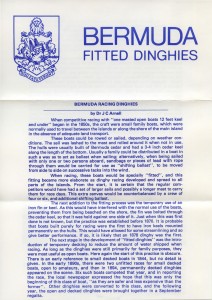
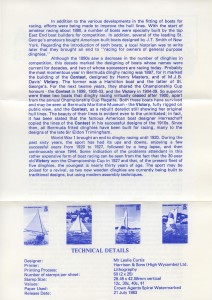
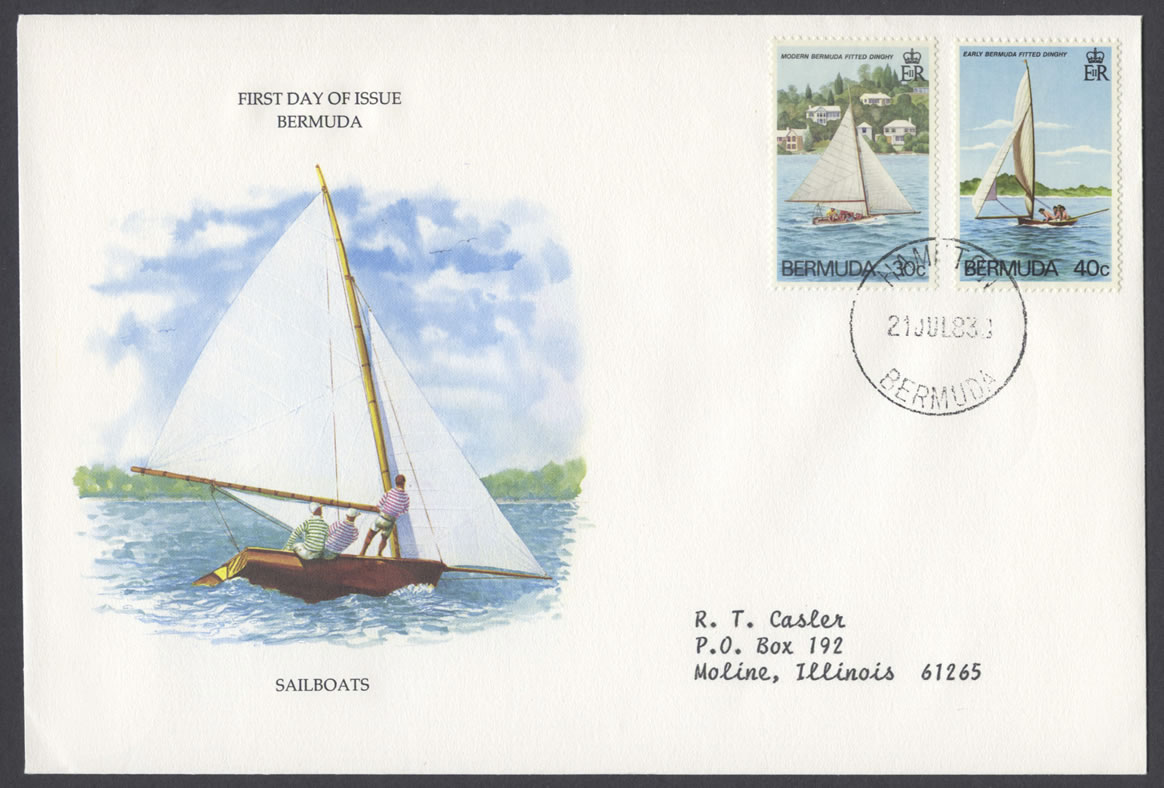
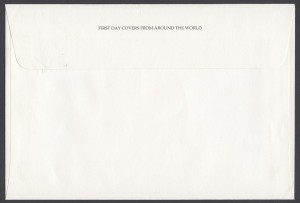
Leave a Reply
You must be logged in to post a comment.